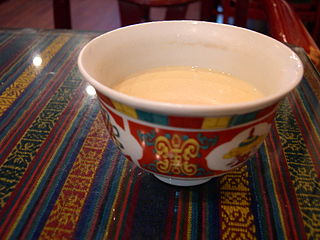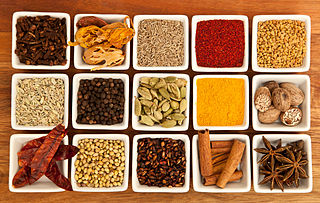 W
WThis is a list of Tibetan dishes and foods. Tibetan cuisine includes the culinary traditions and practices of Tibet and its peoples, many of whom reside in India and Nepal. It reflects the Tibetan landscape of mountains and plateaus and includes influences from neighbors. It is known for its use of noodles, goat, yak, mutton, dumplings, cheese, butter and soups.
 W
WTibetan cuisine includes the culinary traditions and practices and its peoples. The cuisine reflects the Tibetan landscape of mountains and plateaus and includes influences from neighbors. It is known for its use of noodles, goat, yak, mutton, dumplings, cheese, butter, yogurt, and soups. Vegetarianism has been debated by religious practitioners since the 11th century but is not prevalent due to the difficulty of growing vegetables, and cultural traditions promoting consumption of meat.
 W
WThe production of beer in Tibet is a relatively recent phenomenon in Tibetan cuisine. The Chinese established the Lhasa Brewery Company in 1988, which is located in Lhasa. It is the highest brewery in the world.
 W
WButter tea, also known as po cha, cha süma, Mandarin Chinese: sūyóu chá or gur gur cha in the Ladakhi language, is a drink of the people in the Himalayan regions of Nepal, Bhutan, India and Tibet and other Western regions of modern-day China. Traditionally, it is made from tea leaves, yak butter, water, and salt, although butter made from cow's milk is increasingly used, given its wider availability and lower cost.
 W
WCentury eggs, also known as preserved eggs, hundred-year eggs, thousand-year eggs, thousand-year-old eggs, millennium eggs, skin eggs, or black eggs, are a Chinese egg-based culinary dish made by preserving duck, chicken or quail eggs in a mixture of clay, ash, salt, quicklime, and rice hulls for several weeks to several months, depending on the method of processing.
 W
WChhaang or chang is a Nepalese and Tibetan alcoholic beverage also popular in parts of the eastern Himalayas, Yakkha, Limbu, Newar, Sunuwar, Rai, Gurung, Magar, Sherpa, Tamang and Lepcha communities. Among the Lepcha, it is called Chi.
 W
WChhurpi or durkha is a traditional cheese consumed in the Himalayan regions of Nepal, Sikkim, Darjeeling, and Tibet. The two varieties of chhurpi are a soft variety and a hard variety.
 W
WKhapse or amjok is a Tibetan/Sherpa biscuit that is traditionally prepared during the Tibetan/Sherpa New Year or Losar. The dough for the khapse is usually made with flour, eggs, butter and sugar and is then shaped into different shapes and sizes.
 W
WLaping is a spicy cold mung bean noodle dish in Tibetan cuisine. It is a street food and is also popular in some parts of Nepal. It can be eaten with red pepper chili, coriander and green onion sauce. The noodles have a slippery texture and are served with a soy sauce gravy. It is traditionally a summer food. A tool is used to shape it. The laping derives from the Sichuan-style liangfen.
 W
WMomo is a type of Tibetan dumpling dish. It is popular in Tibet, Nepal, India and in the regions straddling the Himalayas between South Asia and East Asia. Momo is found in the cuisines of Nepal & Tibet. It is similar to baozi, jiaozi and mantou in Chinese cuisine, buuz in Mongolian cuisine, gyoza in Japanese cuisine, mandu in Korean cuisine and manti in Turkic cuisines, albeit heavily influenced by the cuisine of the Indian subcontinent with Indian spices and herbs. Momo is extremely popular in South Asia and can be found in every kind of shop from restaurants to street vendors.
 W
WShabhaley, also known as sha phaley, is a Tibetan dish of bread stuffed with seasoned meat and cabbage, which is then fashioned into semi-circular or circular shapes and which according to regional variations is either deep fried or pan fried like pot stickers.
 W
WSikkimese cuisine is the cuisine of the state of Sikkim, located in northeastern India. Rice is a staple food, and fermented foods traditionally constitute a significant portion of the cuisine. Nepalese cuisine is popular, as Sikkim is the only state of India with an ethnic Nepali majority. Many restaurants in Sikkim serve various types of Nepalese cuisine, such as the Newa and Thakali cuisines. Tibetan cuisine has also influenced Sikkimese cuisine. Sikkim has a blend of cultures and traditions of Nepal, India, Bhutan and Tibet. So, does the cuisine of this state. The combination of various cuisines has resulted in one specific cuisine, which is now called as cuisine of Sikkim.
 W
WA soup-like vegetable curry in Tibetan cuisine that is often served with tingmo steamed bread.
 W
WThenthuk or hand-pulled noodle soup (thukpa), is a very common noodle soup in Tibetan cuisine, especially in Amdo, Tibet where it is served as dinner and sometimes lunch. The main ingredients are wheat flour dough, mixed vegetables and some pieces of mutton or yak meat. Vegetable thenthuk is a common modern day option too.
 W
WThukpa is a Tibetan noodle soup, which originated in the eastern part of Tibet. Amdo thukpa is a famous variant amongst the Indians, Tibetans and the people of Nepal. There are numerous varieties of thukpa in Tibetan tradition, including:Thenthuk : Hand-pulled noodle Gyathuk : Chinese noodle Thuppa Thugpa : Hand-rolled pinched noodle Drethug
 W
WTibetan cheese is a food staple in Tibetan cuisine. Tibetan cheeses include soft cheese curds resembling cottage cheese made from buttermilk called chura loenpa. Hard cheese is called chura kampo. Extra hard cheese, made from solidified yogurt, is called chhurpi, and is also found in Sikkim and Nepal. Another type of cheese called shosha or churul, with a flavor said to resemble Limburger, is made from cream and the skin of milk.
 W
WTingmo is a steamed bread in Tibetan cuisine. It is sometimes described as a steamed bun that is similar to Chinese flower rolls. It does not contain any kind of filling. A tingmo with some type of filling, like beef or chicken, is called a momo.
 W
WTsampa or Tsamba is a Tibetan and Himalayan staple foodstuff, particularly prominent in the central part of the region. It is glutinous meal made from roasted flour, usually barley flour and sometimes also wheat flour. It is usually mixed with the salty Tibetan butter tea. It is also eaten in Turkestan and Mongolia, where it is known as zamba.
 W
WYak butter is butter made from the milk of the domestic yak. Many herder communities in China, India, Mongolia, Nepal, and Tibet produce and consume dairy products made from yak's milk, including butter. Whole yak's milk has about twice the fat content of whole cow's milk, producing a butter with a texture closer to cheese. It is a staple food product and trade item for herder communities in south Central Asia and the Tibetan Plateau.